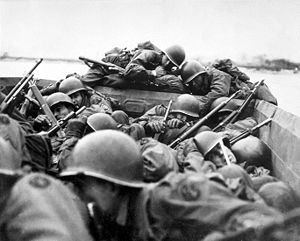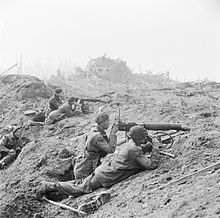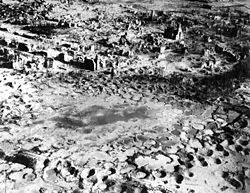- Operation Plunder
-
Operation Plunder Part of Western Allied invasion of Germany, World War II 
Soldiers from the US 89th Infantry Division cross the Rhine River in assault boats, under intense German fireDate 24 March 1945 Location North Rhine-Westphalia, Germany Result Allied victory Belligerents  United Kingdom
United Kingdom
 Canada
Canada
 United States
United States Germany
GermanyCommanders and leaders  Bernard Montgomery
Bernard Montgomery Johannes Blaskowitz
Johannes BlaskowitzOperation Varsity was the airborne component of Plunder Veritable - Grenade - Lumberjack - Plunder - Varsity - Ruhr Pocket - Undertone - Battle of Kassel - Battle of Heilbronn - Amherst - ArchwayCommencing on the night of 23 March 1945 during World War II, Operation Plunder was the crossing of the River Rhine at Rees, Wesel, and south of the Lippe River by the British 2nd Army, under Lieutenant-General Sir Miles Dempsey (Operations Turnscrew, Widgeon, and Torchlight), and the U.S. Ninth Army (Operation Flashpoint), under Lieutenant General William Simpson. XVIII U.S. Airborne Corps, consisting of British 6th Airborne Division and U.S. 17th Airborne Division, conducted Operation Varsity, parachute landings on the east bank in support of the operation. All of these formations were part of the 21st Army Group under Field Marshal Sir Bernard Montgomery. This was part of a coordinated set of Rhine crossings.
Contents
Background
Preparations (accumulation of supplies, road construction and the transport of 36 Royal Navy landing craft) were hidden by a massive smoke screen from 16 March. The operation commenced on the night of 23 March 1945. It included the Varsity parachute and glider landings near Wesel, and Operation Archway, by the Special Air Service. The landing areas were flooded, deserted farmland rising to woodland.
Battle
The opening bombardment was by 4,000 guns firing for four hours. British bombers contributed with attacks on Wesel during the day and night of 23 March.
Three Allied formations made the initial assault: the British XXX and XII Corps and the U.S. XVI Corps. One unit, the British 79th Armoured Division—under Major-General Sir Percy Hobart—had been at the front of the Normandy landings and provided invaluable help in subsequent operations. They specialised in providing solutions to all situations with specially adapted armoured vehicles (referred to as Hobart's Funnies). One "funny" was the "Buffalo", an armed and armored amphibious tracked personnel or cargo transporter able to cross soft and flooded ground. These were the transports for the spearhead infantry.
The first part of Plunder was initiated by the 51st (Highland) Infantry Division, led by the 7th Black Watch at 21:00 on 23 March, near Rees, followed by the 7th Argyll and Sutherland Highlanders. At 02:00 on 24 March, the 15th (Scottish) Division landed between Wesel and Rees. At first, there was no opposition, but later they ran into determined resistance from machine-gun nests. The British 1st Commando Brigade entered Wesel.
The U.S. 30th Division landed south of Wesel. The local resistance had been broken by artillery and air bombardment. Subsequently, the 79th Division also landed. U.S. casualties were minimal. German resistance to the Scottish landings continued with some effect, and there were armoured counter-attacks. Landings continued, however, including tanks and other heavy equipment. The U.S. forces had a bridge across by the evening of 24 March.
Operation Varsity started at 10:00 on 24 March, to disrupt enemy communications. Despite heavy resistance to the airdrops and afterward, the airborne troops made progress and repelled counterattacks. The hard lessons of Operation Market Garden were applied. In the afternoon, 15th Scottish Division linked up with both airborne divisions.
Fierce German resistance continued around Bienen, north of Rees, where the entire 9th Canadian Brigade was needed to relieve the Black Watch. The bridgehead was firmly established, however, and Allied advantages in numbers and equipment were applied. By 27 March, the bridgehead was 35 mi (56 km) wide and 20 mi (32 km) deep.
Aftermath
Impact on German forces and command
The Allied operation was opposed by the German 1st Parachute Army, commanded by General Alfred Schlemm, a part of Army Group H. Although this formation was considered to be the most effective German force in the area, it was severely depleted from its previous action in the Reichswald (Battle of the Reichswald). Unable to withstand Allied pressure, the 1st Parachute Army withdrew northeast toward Hamburg and Bremen, leaving a gap between it and the German 15th Army, in the Ruhr.
Joseph Goebbels was well aware of Plunder′s potential impact from the beginning. On 24 March, he began his diary entry with, "The situation in the West has entered an extraordinarily critical, ostensibly almost deadly, phase." He went on to note the crossing of the Rhine on a broad front, and foresaw Allied attempts to encircle the Ruhr industrial heartland.
On 27 March, command of the 1st Parachute Army was passed to General Günther Blumentritt, because Schlemm had been wounded. Blumentritt and his superior, Generaloberst (Colonel General) Johannes Blaskowitz, both recognised that the situation was lost. The army′s front was incomplete, there were no reserves, weak artillery, no air support and few tanks. Communications were weak, indeed, one corps was never contacted. The reinforcements were so poor that the generals decided against using them, to avoid needless casualties.
Although Blumentritt had strict orders from Supreme Command to hold and fight, from 1 April, he managed a withdrawal with minimal casualties, eventually withdrawing beyond the Dortmund-Ems Canal to the Teutoburg Forest. Within a week of the start of Plunder, the Allies had taken 30,000 prisoners of war north of the Ruhr.
Winston Churchill
British Prime Minister Winston Churchill was present at Field Marshal Montgomery′s headquarters near Venlo on the eve of Plunder (23 March). Subsequently, Churchill and Montgomery watched the Varsity air landings on 24 March.
The next day, 25 March, Churchill and Montgomery visited General Dwight D. Eisenhower′s headquarters. After lunch and a briefing, the party went to a sandbagged house overlooking the Rhine and a quiet, undefended stretch of the German-held riverbank. After Eisenhower′s departure, Churchill, Montgomery, and a party of U.S. commanders and armed guards commandeered a river launch and landed for 30 minutes in enemy territory, without challenge. They next visited the destroyed railway bridge at Wesel, departing when German artillery appeared to target them.
Military rivalries
Although the operation was successful, it exposed further the irritation, or worse, held by most U.S. generals toward Montgomery. It also showed, perhaps, the downside of Montgomery′s careful approach toward major operations. Montgomery had angered the U.S. commanders repeatedly, in operations in Sicily, Normandy and after the Battle of the Bulge. His reputation had further suffered over Operation Market Garden and the failure to open Antwerp to shipping until November 1944.
The Plunder crossings had long been intended as the major assault across the Rhine, but at the Malta Conference in early February 1945, Eisenhower added more crossings to the south of the Ruhr. In advance of these, on 7 March, U.S. troops took advantage of a failed bridge demolition at Remagen to form a threatening bridgehead across the Rhine. General George S. Patton—a bitter critic of Montgomery—used his 3rd Army to force a bridgehead south of the Main, opposite Oppenheim. News of this was released "at a time calculated to take some of the luster from the news of Montgomery′s crossing."[1]
Patton made the point that Montgomery's preparations were, in his view, unnecessarily cautious and he demonstrated that the Germans could be "bounced", if caught before they had time to prepare defences. While the Allies prepared, XLVII Panzer Corps had rested, re-equipped and absorbed reinforcements in relative safety in the Netherlands. Once needed, they were a fresh formation to oppose the bridgehead. At Bienen and elsewhere, the Anglo-Canadians faced German troops in prepared positions.
The large airborne assault (Varsity) has been criticised as unnecessary and costly in terms of casualties and aircraft lost. Montgomery annoyed Americans by his initial proposal to use U.S. divisions, under his command.
Counter-arguments are that German reserves had been drawn south to seal-off the unexpected American bridgehead Remagen and they would otherwise have been expected to oppose Plunder. The marshy terrain and width of the Rhine at Wesel were serious impediments that required specialised resources. At Remagen, the bridge aided exploitation, and at Oppenheim, Patton was unopposed because the area was isolated from strategic objectives by distance and by the River Main.[2]
Notes
- ^ "Chapter XIII The Rhine Crossings in the South". US Army in World War II, The Last offensive. OFFICE OF THE CHIEF OF MILITARY HISTORY, DEPARTMENT OF THE ARMY. 1973. p. 273. http://www.ibiblio.org/hyperwar/USA/USA-E-Last/USA-E-Last-13.html. Retrieved 9 February 2011.
- ^ The agreed Allied strategic objective was to capture the German industrial heartland of the Ruhr. To this end, Plunder and subsequent U.S. operations were to deliver the necessary forces to encircle the region.
Bibliography
- Saunders, Tim (2006). Operation Plunder. Battleground Europe. Barnsley, UK: Pen & Sword. ISBN 1 84415 221 9.
- Shulman, Milton (1995, (first published 1947)). Defeat in the West. Chailey, UK: Masquerade. pp. 310–311. ISBN 1-872947-03-4.
- Churchill, Winston (1960). The Second World War. London: Cassell. pp. 301–305.
- Moore, William (1986). Decisive Battles. England: Windward. pp. 118–124. ISBN 0-7112-0453-5.
External links
Categories:- Battle of Central Europe
- Operation Plunder
Wikimedia Foundation. 2010.



